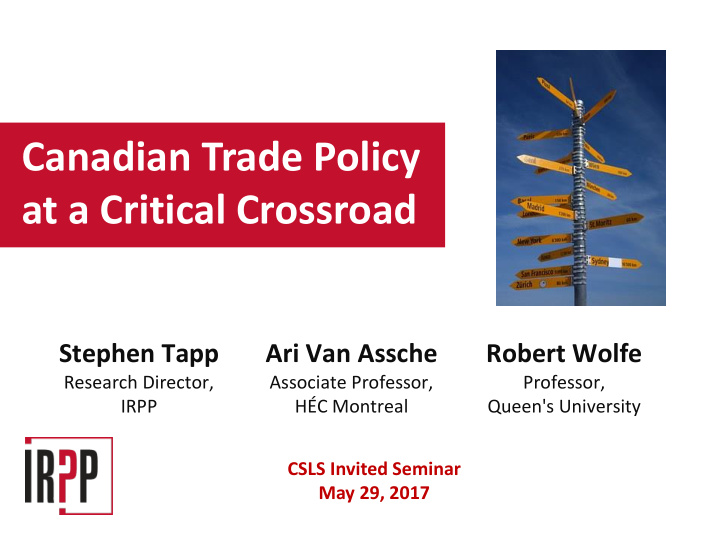



Canadian Trade Policy at a Critical Crossroad Stephen Tapp Ari Van Assche Robert Wolfe Research Director, Associate Professor, Professor, IRPP HÉC Montreal Queen's University CSLS Invited Seminar May 29, 2017
The elephant in the room Keep a long-run perspective
Our approach to see The elephant in the room the forest for the trees Keep a long-run perspective • forward-looking, medium-term medium-term • empirical empirical • analytical analytical • international international • interdisciplinary interdisciplinary
New Global Trade Realities 1. Resource reallocation within industries is a key driver of trade and productivity. 2. SMEs face long-standing challenges but have new opportunities. 3. Production processes are fragmented, collaborative and global. 4. Foreign affiliates and services are strong enablers of international commerce. 5. Emerging markets are now key players in production, trade and investment. 6. Global output and trade growth has slowed. 7. Anti-trade sentiment and economic anxiety have risen. 8. Trade talks are largely stalled.
Many anxieties…trade deals a target technological change globalization trade automation trade deals offshoring precarious work secular stagnation winner-take-most markets inequality “middle class” struggles immigration reduced worker bargaining power rent-seeking lax corporate governance
Editors’ overarching recommendation Develop more inclusive trade policy Inclusive growth labour education Inclusive trade infrastructure competition innovation taxation
What’s “new” in new, new trade? Firm-level differences – size – productivity Key mechanisms – Reallocation within industries – New ( “ extensive ” margin) trade
Only the most productive firms can jump over the fixed cost hurdle of exporting (baseline Melitz model) Profits Productivity Don’t Non-exporters Exporters produce
Share of Canada’s goods exports (2015, percent of total)
Trade share and productivity, 1970-2015
Change in trade status and productivity gaps among manufacturing firms, 2002-06
Trade liberalization reallocates resources towards more productive firms 11
How the Canada-US FTA raised our manufacturing productivity (Mechanisms’ estimated contributions to total)
How the Canada-Chile FTA increased our exports (Mechanisms’ estimated contributions to total)
Firm-level insights • More productive firms trade… … and trade makes firms more productive. • Trade liberalization raises productivity by creating new opportunities abroad… and increasing competitive pressure at home, which shifts resources between firms. • Consider distributional impacts. • Reduce fixed trade costs.
Policy pillar: Facilitate resource reallocation 1. Put resources to their best uses 2. Protect workers, not jobs
Global value chain production Sourcing of Boeing 787 parts
Real export growth (2000-15, average annual percent change)
Shares of US merchandise imports, 1987-2016 (percent of total)
Share of foreign value added in gross exports, 1995 and 2011 (percent of total)
EDC’s integrative trade approach 20
Canada’s outward FDI, foreign affiliate sales and exports (2004-13, cumulative nominal percent change)
Canadian exports and foreign affiliate sales (2014, billions of dollars)
Canada’s share of services, by activity (percent of total)
Canada’s dependence on the US (2013, percent of total) 73 48 41 Exports Foreign affiliate sales Outward FDI
GVC insights • Local linkages embedded in larger networks. • Competition between value chains, not only firms. • Connectedness is key to our productivity. • Strength in partnerships. 25
Policy pillar: Promote international connectivity 1. Liberalize exports and imports 2. Facilitate the transmission of goods, capital and information at, and behind, the border 3. Relax rules of origin 4. Protect outward FDI; relax inbound restrictions in “networked” services sectors 5. Help companies identify/connect to strong GVCs
Previous proliferation of regional trade agreements…
…but many talks now are stalled. Trade deal Status CETA proceeding TPP, TiSA, TTIP on hold WTO (Doha) on life support NAFTA in waiting
NAFTA is front of mind…
…shouldn’t obscure the EU’s importance
…or overlook where trade growth is fastest
…the value in trade with dvlpg countries
…or the potential residual value of TPP
Policy pillar: Work with other countries 1. Think and act multilaterally first 2. Maintain preferential North American market access 3. Ensure CETA’s smooth implementation 4. Pay special attention to Asia: engage China, but be cautious of further bilaterals 5. Make trade and dvlpt mutually supportive
Policy pillar: More inclusive trade policy 1. Support SMEs 2. Apply a gender lens to trade 3. Enhance public engagement 4. Study trade’s distributional impacts 5. Ensure trade is sustainable
Conclusion Canada needs a trade policy agenda that: • is more inclusive • facilitates resource reallocation • promotes international connectivity • builds a better global trading system .
Our Policy Priorities Develop more inclusive trade policy • Support SMEs • Apply a gender lens to trade • Enhance public engagement • Study trade's distributional impacts • Ensure trade is sustainable Facilitate resource reallocation • Project workers not jobs Promote international connectivity • Make Canada a more desirable place to perform high-value-added tasks Work with other countries • Multilateral first • Maintain preferential North American market access • Ensure CETA’s smooth implementation • Pay special attention to Asia, but proceed cautiously on further bilaterals • Make trade and development policy mutually supportive
Recommend
More recommend